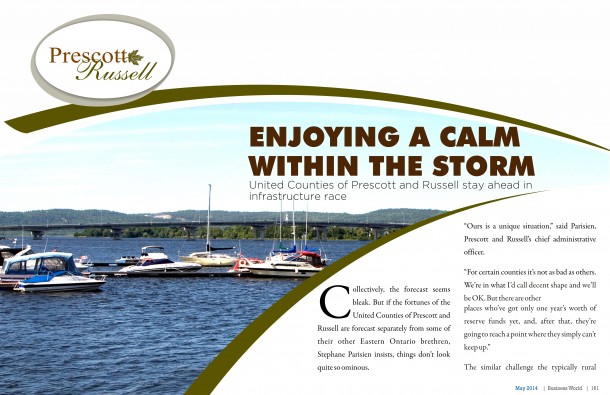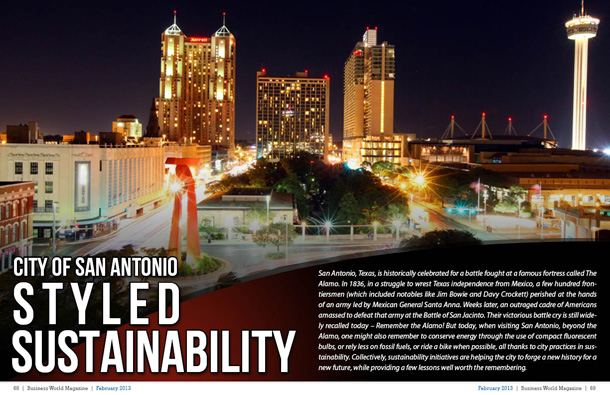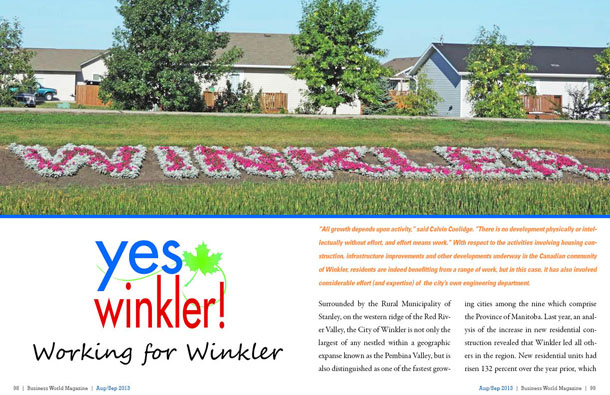
Enjoying a Calm within the Storm
United Counties of Prescott and Russell stay ahead in infrastructure race

Â
Collectively, the forecast seems bleak.
But if the fortunes of the United Counties of Prescott and Russell are forecast separately from some of their other Eastern Ontario brethren, Stephane Parisien insists, things don’t look quite so ominous.
“Ours is a unique situation,†said Parisien, Prescott and Russell’s chief administrative officer.
“For certain counties it’s not as bad as others. We’re in what I’d call decent shape and we’ll be OK. But there are other places who’ve got only one year’s worth of reserve funds yet, and, after that, they’re going to reach a point where they simply can’t keep up.â€
The similar challenge the typically rural municipalities face is an aging infrastructure melded with the lack of a significant revenue base – either from a swelling population or the influx of tax-paying corporate conglomerates – to offset the day-to-day costs of keeping it in working order.
Those fiscal obstacles were the topic of an April 23 article in the Ottawa Citizen, in which Jean Paul St. Pierre, mayor of Russell Township – home to 15,247 people within the united counties’ borders – likened the region’s fate to a famed vessel which sank about 650 kilometers off Canadian shores.
A report released by 13 regional wardens, whose combined entity is referred to as the Eastern Ontario Wardens’ Caucus, claimed household incomes in the region are $10,000 beneath the provincial average, the tax-assessment base climbs as high as 90 percent in some counties and the population aged 65 years and older is above 25 percent in some areas.
Those statistics are coupled with the reality of maintaining a transportation network that includes 5,000 bridges and 69,000 kilometers of roads.
“It’s critical right now, but the trend is getting worse,†St. Pierre said. “By 2020, which is only six years away, we’re going to be in dire straits. The trend is scary. We’re on the Titanic and the ship is sinking.â€
Parisien was also quoted in the Citizen article, but both he and colleague Marc Clermont, director of public works for the united counties, claim Prescott and Russell have a pretty good handle on the 600 kilometers or roads and 100 bridges that fall under their combined charge.
In fact, Clermont said, enough catch-up road and bridge work should be done over the next five years – thanks to a beneficial relationship with budget-makers and the absence of significant long-term debt – to get the counties onto a level maintenance playing field going forward.
“We used to have a lot more of a patchwork approach and we were never really able to get ahead of the workload,†he said. “But things kind of turned around in 2007 and 2008, we had a lot of short-term that we cleared away, which left about $1.5 million each year to deal with funding instead of paying off the credit card.â€
The counties have been joined administratively since 1820 and were home to 85,381 people at the time of the 2011 census, a moderate rise of just more than 5,000 over five years, but one that’s been sparked by the arrival of commuters who choose tom live rurally and work in nearby Ottawa – whose downtown neighborhood begins about 30 kilometers from the counties’ westernmost point.
Many residents on the counties’ eastern side, which borders Quebec, take a similar ride into Montreal for daily work, leaving a vast section of land in between – the counties’ total area is just more than 2,000 square kilometers – which Clermont and Parisien characterize as “very agricultural.â€
Nearly two-thirds of the population – 66.2 percent – label French as their primary language, making Prescott and Russell the most French-heavy Canadian census division west of Quebec.
“Our proximity to Ottawa and Montreal helps makes us attractive, yes,†Parisien said, “but we consider it a good place to live, period, not just because of what we’re close to. It’s based on that that we’re trying to promote growth, and we need to get ourselves to the point where we’re development ready.â€
The public works department has a staff of 40 whose daily charge includes everything that’s related to asset management within the counties, including roads and bridges, as well as engineering for both corporate buildings and social housing within Prescott and Russell’s borders. The department’s roads section specifically employs 25 of the overall 40.
An annual budget of approximately $25 million – including $10 million for capital works – is what Parisien and Clermont are given to work with, and while the hours in the day are spread out between the various aforementioned departmental tasks, the majority of the monies are earmarked for road and bridge work.
“We took direction years ago that, regardless of budgets, we’re to make the cuts elsewhere,†Parisien said. “There’s upkeep that needs to needs to be done every year and the council has made it a priority to keep up the road network. I’d say it’s in decent shape as a whole. There may be some sections that wouldn’t meet that criteria, but it’s certainly in better shape than Marc and I collectively.â€
Increased use of recycled asphalt in maintenance has been both a cost-conscious and environmentally initiative undertaken in recent years, while just about all of the counties’ traffic lights have been recently converted to LED bulbs – which provides an energy benefit, a cost savings and reduces the recurring need for fixing or replacing lights.
Next on the agenda in terms of major projects is the improvement of a stretch of County Road 17 that runs from a Highway 34 interchange to a point approximately 800 meters east of Tupper Street in the town of Hawkesbury.
A municipal-class environmental assessment is already under way to provide a detailed evaluation of future transportation demands for the east-west road between Hawkesbury and Champlain Township. The study is designed to assess existing network deficiencies and develop a recommended plan to address capacity, operational and safety issues while minimizing environmental impact.
The stretch of road was downloaded from provincial to county jurisdiction in 1998.
“That’s the killer highway out there right now,†Clermont said. “There’s too much traffic on a two-lane heading to Ottawa. At the rate we’re going now, we’ll be in decent to very good shape in the future. The intent is to make up the gap between catching up and staying ahead, and I do believe we’ll get there.â€
Â
AT A GLANCE
WHO: United Counties of Prescott and Russell
WHAT: Joint municipality created by union of Prescott and Russell counties in 1820; home to 85,381 residents, according to 2011 census
WHERE: Along the Ottawa River in eastern Ontario – 90 kilometers east of Ottawa, 105 kilometers west of Montreal
WEBSITE: www.Prescott-Russell.on.ca








